#robert lesser collection
Explore tagged Tumblr posts
Text

Paul C. Stahr (American, 1883 - 1953) • Cover for New Worlds science fiction pulp magazine • 1932
#art#illustration#illustrator#artwork#pulp illustration#robert lesser collection#paul stahr#pulp science fiction#new worlds magazine#american illustrator#1930s illustration#sassafras and moonshine blog
8 notes
·
View notes
Text
How to save the Supreme Court from Alito’s ethical malfeasance
The justice’s unconscionable violations of ethics demand the court be reformed.
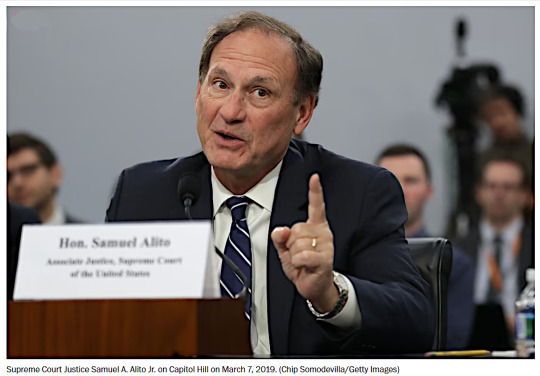
Jennifer Rubin clearly explains why Alito went too far in allowing a symbol of the insurrection to fly over his home, and why the Roberts Court needs to stop slow-walking the presidential immunity decision if the Court is to regain any credibility. This is a gift🎁link so anyone can read the full article, even if they don't subscribe to The Washington Post.
Among the Supreme Court’s abominations — shredding precedent to obliterate reproductive freedom, financial impropriety, partisanship — none compares to the upside-down flag, identified with violent insurrectionists, that flew over the home of Justice Samuel A. Alito Jr. Ethics experts and lawyers (including former judges) of all stripes expressed their outrage. “His statement — which says his wife displayed a symbol associated with a failed coup to subvert democracy because she was offended by an anti-Trump sign one of her neighbors displayed — is so incoherent it is insulting to our collective intelligence,” constitutional law professor Leah Litman emails me. “And a Justice who resides in a house that displays symbols glorifying a coup should not participate in cases that will determine whether people who participated in said coup will face any accountability.” [...] Alito (alongside Justice Clarence Thomas, whose wife encouraged coup plotters) has heard multiple insurrection-related cases, including the pending immunity case that could absolve Trump of criminal liability. In letting his home stand in solidarity with constitutional arsonists, Alito made a mockery of his oath to “faithfully and impartially discharge” his duties under the Constitution. Any other judge (especially one implicated in financial misconduct) would be compelled to resign and/or face the threat of impeachment. So what about Alito? Immediate Triage Unlike its speedy disposition of the 14th Amendment case (24 days after argument) and of many lesser matters, the court put the immunity case in deep freeze, making it near-impossible to try the ex-president before the next election....The Alito debacle only deepens the impression that the court has its thumb on the scale — or the brake — for Trump. [...] As constitutional scholar Laurence Tribe warns in an email to me, if Roberts “wants the Court to retain any credibility at all,” he must compel the court to “bite the bullet and issue its decision, ....” Then, Tribe explains, “Judge [Tanya S.] Chutkan either can hold whatever hearing the Court thinks necessary to decide exactly which charges against the former president may remain” or can begin the trial itself, which “should have been over by now.” Alito’s ethical self-immolation leaves Roberts no alternative if he wants to dispel the perception that two ethically compromised, partisan justices have thoroughly corrupted the court. (He also should implore Alito to recuse, but who believes that’ll happen?) [emphasis added]
#samuel alito#scotus#corruption#roberts court#presidential immunity#jennifer rubin#the washington post#gift link
125 notes
·
View notes
Text
Hi all,
Welcome to the last part of my 2024 altar tour! 4/4
What a year it has been! I have learned so much and made so many new friends! My altar has always been a reflection of my psyche, seeing it’s beauty reminds me of the beauty that exists within me. :)

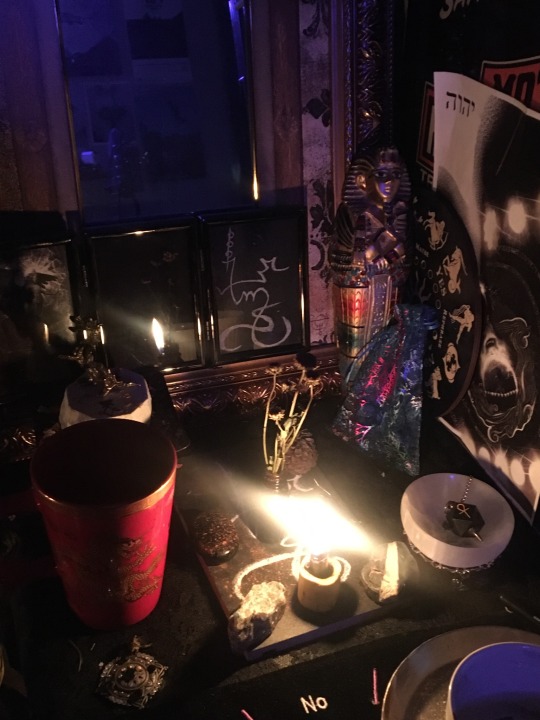

So this is my final little work space where I do pendulum magick and tarot readings. There is a devotional mug to Lord Lucifer which I use for our morning coffee chats. There is also Lucifer’s devotional dragon statue, as well as the dual scrying mirror for him and Faviel.
There is a normal mirror and a statue of a pharaoh’s tomb. The board which the flowers and offerings are placed on dawns Faviel’s sigil and candle. To Faviel I have offered a palm stone, flowers, an acorn, smoky quartz, some black earrings, and some grubs.
Beside him is my pendulum in a selenite charging bowl along with my pendulum mat.
The black and white image you see was a piece of art I made for Archangel Jophiel after he gifted me a vision a year or so ago. I use it whenever I’m reaching out to him.
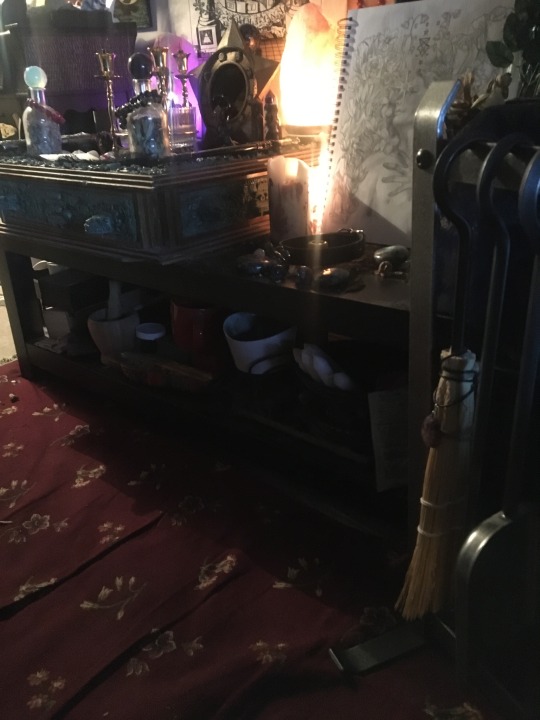
Beneath my altar is some space for storage where I keep my larger cauldron, mortar and pestle, larger candles, etc. There is also my stand where I keep my broom, fire poker, and shovel. My witch broom is wrapped in a protective seal. I use it to sweep ash from my prayer mat.
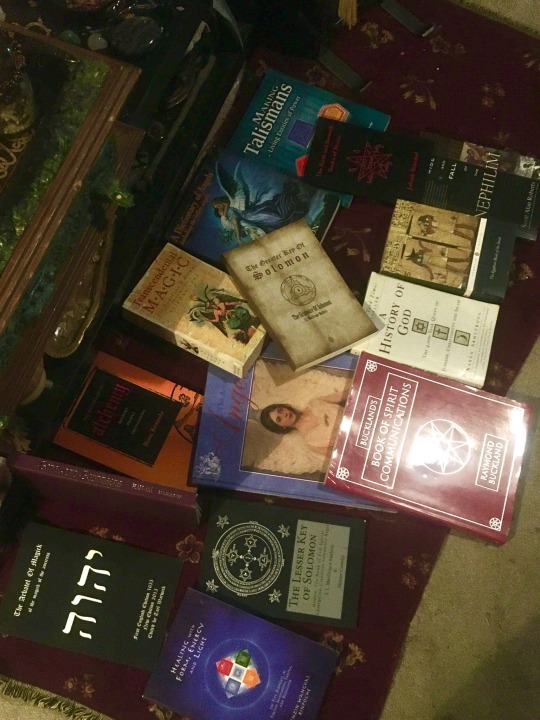

And finally, here are a few of the books I have in my collection that have greatly greatly aided me in my craft. Remember to do your research my dears!
The Arbatel of Magick- First English edition 1633, new edition 2013, edited by Earl Marwick
Healing with Form, Energy, and Light- Tenzin Wangyal Rinpoche
Gods and Goddesses- Hallam, Elizabeth
The Lesser Key of Solomon- S.L MacGregor Mathers and Aleister Crowley
The Dictionary of Alchemy- Diana Fernando
The Art of Angels- Howard Loxton
Backland’s Book of Spirit Communications- Raymond Buckland
Transcendental Magick- Éliphas Lévi
The Greater Key of Solomon- S.L MacGregor Mathers
A History of God- Karen Armstrong
A Dictionary of Angels, Including Fallen Angels- Gustav Davidson
Making Talismans- Nick Farrell
The Sixth and Seventh Books of Moses- Johann Scheibel
The Egyptian Book of the Dead
The Rise and Fall of the Nephilim- Scott Alan Roberts
Buckland’s Complete Book of Witchcraft- Raymond Buckland
Candle Burning Rituals- Raymond Buckland
The Complete Book of Black Magick and Witchcraft
Green Witchcraft, Folk Magick, Fairy Lore & Herb Craft- Ann Moura
The Book of Forbidden Knowledge, Black Magick, Superstition, Charms and Divination- First Edition 1910s Johnson Smith & co. New Edition 2016 edited by Earl Marwick
Three Books of Occult Philosophy- Henry Cornelius Agrippa
and of course, The Holy Bible- New Living Translation.
I have many other books in my collection on tarot and astrology in my living room, but these are the books that have had the greatest impact on my craft. Here are a few of those other ones:
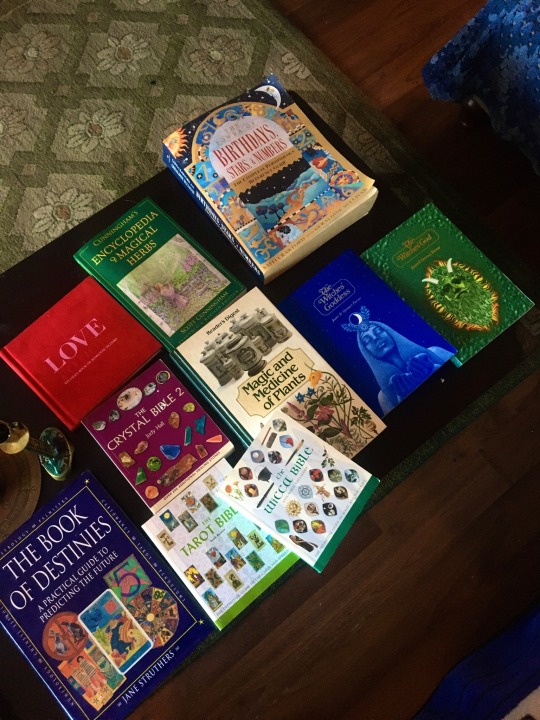
Love Potions- Tatania Hardie
The Book of Destinies- Jane Struthers
The Crystal Bible 2- Judy Hall
The Tarot Bible- Sarah Barlett
The Wicca Bible- Ann Marie Gallagher
Cunningham’s Encyclopedia of Magical Herbs- Scott Cunningham
Magic and Medicine of Plants- Reader’s Digest
The Power of Birthdays Stars and Numbers- Saffi Crawford and Geraldine Sullivan
The Witches’ Goddess- Janet and Stewart Farrar
The Witches’ God- Janet and Stewart Farrar
•••
I wanted to end this tour off with my reading material because I want to emphasize how important it is to understand that “magick” is not just “stuff”.
I really enjoy all of my magical tools and there’s absolutely nothing wrong with having and wanting pretty things or an aesthetically pleasing altar. In fact I believe aesthetic and care are acts of love in themselves. Don’t ever let someone shame you for wanting to decorate and indulge in the aesthetics of your craft.
But please do remember that our greatest magical tool is our minds, our senses, and our experiences- our brains. Remember to read read read lots of material from many different sources. Contemplate honestly on everything you read, hear and experience. Do not take everything you believe today as a fact, do not box yourself in to anything. (Maybe that’s the Luciferian in me speaking lol)
Learn how to do magick alone, without any tools. My magick is not my stuff, although my stuff greatly aids me in my magick. Does that make sense?
Thank you so much for reading! I look forward to growing and learning so much more this year! :)
Blessed be!
#magick#witchcraft#occultism#witch community#demonology#pagan#paganism#witch aesthetic#witchblr#grimoire#altar#altar tour#spell work#spellcraft#divination#pagan witch#deity work#deity worship#daily devotion#devotee
82 notes
·
View notes
Text
Bibliography:
Alchemy and the Occult:
Western:
Alchemy Unveiled, Johannes Helmond (Translated into English and Edited by
Gerard Hanswille and Deborah Brumlich); (1963)
Practical Alchemy, A Guide To The Great Work; Brian Cotnoir (2006)
The Black Arts (50th Anniversary Edition); Richard Cavendish (1968)
Alchemy & Mysticism: The Hermetic Cabinet; Alexander Roob (2009)
The Forge and the Crucible: The Origins and Structures of Alchemy (2nd Edition); Mircea Eliade (1962, 1978)
History of Alchemy; M. M. Pattison (1902)
Alchemy (Revised Edition); E. J. Holmyard (1990)
Dictionary of Symbolism, Cultural Icons and the Meanings Behind Them; Hans Biedermann, Translated by James Hulbert (1994)
The Encyclopedia of Witches, Witchcraft, and Wicca; Rosemary Ellen Guiley (1989)
The Encyclopedia of Ghosts and Spirits; Rosemary Ellen Guiley (1992)
Levantine:
The Jewish Alchemists: A History and Source Book; Raphael Patai (1994)
Ancient Magic and Divination, A Microhistorical Study of the Neo-Assyrian Healer Kiṣir-Aššur; Troels Pank Arbøll (2017)
Fuck Your "Magic" Antisemitism: A Lesser Key To The Appropriation Of Jewish Magic & Mysticism; Ezra Rose (2022)
“His wind is released” - The Emergence of the Ghost Ritual of passage in Mesopotamia; Dina Katz, Leiden (2014)
Cursed Are You! The Phenomenology of Cursing in Cuneiform and Hebrew Texts; Anne Marie Kitz (2014)
Egyptian Magic; E.A. Wallis Budge (1901)
Mesopotamian Planetary Astronomy-Astrology (Cuneiform Monographs); David Brown (2000)
Astrology in Ancient Mesopotamia: The Science of Omens and the Knowledge of the Heavens; Michael Baigent (July 20, 2015)
Ancient Jewish Magic: A History; Gideon Bohak (2008)
PERFORMING DEATH: SOCIAL ANALYSES OF FUNERARY TRADITIONS IN THE ANCIENT NEAR EAST AND MEDITERRANEAN; Nicola Laneri, Ellen F. Morris, Glenn M. Schwartz, Robert Chapman, Massimo Cultraro, Meredith S. Chesson, Alessandro Naso, Adam T. Smith, Dina Katz, Seth Richardson, Susan Pollock, Ian Rutherford, John Pollini, John Robb, and James A. Brown (2007)
Mesopotamian Conceptions of Dreams and Dream Rituals; Sally A. L. Butler (1998)
Forerunners to Udug-Hul: Sumerian exorcistic incantations; Markham J. Geller (1985)
Šurpu. A Collection of Sumerian and Akkadian Incantations; Erica Reiner (1958)
Mesopotamian Protective Spirits: The Ritual Texts; F. A. M. Wiggermann (1992)
The Alchemist's Handbook- Manual for Practical Laboratory Alchemy; Frater Albertus (1960)
Licit Magic: The Life and Letters of al-Ṣāḥib b. ʿAbbād (d. 385/995); Maurice A. Pomerantz (09 Nov 2017)
Further Studies on Mesopotamian Witchcraft Beliefs and Literature; Tzvi Abusch (2002)
The Heavenly Writing: Divination, Horoscopy, and Astronomy in Mesopotamian Culture; Francesca Rochberg (2004)
Greco-Roman:
Magic, Witchcraft, and Ghosts in Greek and Roman Worlds: A Sourcebook; Daniel Ogden (2002)
Far East Asia:
I Ching; Fu Xi (~1000 BCE)
Myths, Legends, Religious Texts And Folktales
Levantine:
The Treasures of Darkness: A History of Mesopotamian Religion; Thorkild Jacobsen (1976)
Persian Myths; Jake Jackson (2022)
Myths of Babylon; Jake Jackson (2018)
The Epic Of Gilgamesh (2nd Edition); Anonymous, Andrew George (????, 2000)
The First Ghost Stories; Dr. Irving Finkel (2021)
On Jewish Folklore; Raphael Patai (1983)
Sumerian Mythology, a Deep Guide Into Sumerian History and Mesopotamian Empire and Myths; Joshua Brown (2021)
Sumerian Mythology, a Study of Spiritual and Literary Achievement in the Third Millennium B.C. (Revised Edition); Samuel Noah Kramer (1961)
Sumerian Liturgies; Anonymous, Stephen Langdon (1919)
Inanna, Lady of Largest Heart, Poems of the Sumerian High Priestess Enheduanna; Enheduanna, Betty De Shong Meador (1989)
Ninurta's Journey to Eridu; Daniel Reisman (1971)
A Sumerian Proverb Tablet in Geneva With Some Thoughts on Sumerian Proverb (2006)
Enki's Journey to Nippur: The Journeys of the Gods; Al-Fouadi, Abdul-Hadi A. (1969)
The Arthur of the Welsh: The Arthurian Legend in Medieval Welsh Literature by Rachel Bromwich (1991)
Encyclopedia of American Folklore; Linda S. Watts (2006)
Jewish Magic and Superstition: A Study in Folk Religion; Joshua Trachtenberg (1939)
Amulets and Talismans; E.A. Wallis Budge (The copy I have was published in 1992 but he died in 1934. Not sure when the original work was created.)
Ashkenazi Herbalism: Rediscovering the Herbal Traditions of Eastern European Jews; Deatra Cohen, Adam Siegel (2021)
Encyclopedia of Catholicism; Frank K. Flinn (2007)
As Through a Veil: Mystical Poetry in Islam; Annemarie Schimmel (1982)
You Will Have Other Goddesses in Addition to Me: Polytheism Among Ancient Israelite Women; Liora Finke (2022)
Gods That Travel: On The Ritual Aspects of Divine Journeys And Processions; Klaus Wagensonner (2014)
NINURTA AND ENKI; A new divine journey of the warrior god to Eridu; Klaus Wagensonner (2013)
Jewish Music in Its Historical Development; Abraham Zevi Idelsohn (1929)
The God Enki in Sumerian Royal Ideology and Mythology; Peeter Espak (2010)
The Encyclopedia of Jewish Myth, Magic & Mysticism: Second Edition; Geoffrey W. Dennis (2007)
Book of Jewish Knowledge: An Encyclopedia of Judaism and the Jewish People, Covering All Elements of Jewish Life from Biblical Times to the Present (03 May 1948); Nathan Ausubel
Encyclopedia of Judaism (Encyclopedia of World Religions); Sara E. Karesh & Mitchell M. Hurvitz (2006)
Aboriginal Australia:
Gadi Mirrabooka: Australian Aboriginal Tales from the Dreaming; Pauline E. McLeod, Francis Firebrace Jones, June E. Barker, Helen F. McKay (2001)
The Two Rainbow Serpents Travelling: Mura Track Narratives from the 'Corner Country'; Jeremy Beckett, Luise Hercus (2009)
Mixed or Other:
Egyptian Myths & Tales; Japanese Myths & Tales, Aztec Myths & Tales, Scottish Folk & Fairytales, Viking Folk & Fairytales, Chinese Myths & Tales, Greek Myths & Tales, African Myths & Tales, Native American Myths & Tales, Persian Myths & Tales, Celtic Myths & Tales, Irish Fairy Tales; Anonymous, Flame Tree Publishing
Tales of King Arthur & The Knights Of The Round Table (Le Morte D’Arthur); Thomas Malory
The Encyclopedia of Celtic Mythology and Folklore; Patricia Monaghan (2004)
Academic (Science including Psychology)
Stellar Alchemy: The Celestial Origin of Atoms, Michel Cassé, Stephen Lyle (2003)
Aboriginal Suicide Is Different: A Portrait of Life And Self Destruction; Colin Tatz (2005)
Fruit Domestication in the Near East; Shahal Abbo, Avi Gopher & Simcha Lev-Yadun (2015)
Astronomical Cuneiform Texts: Babylonian Ephemerides of the Seleucid Period for the Motion of the Sun, the Moon, and the Planets (Sources in the History of Mathematics and Physical Sciences, 5); Otto E. Neugebauer (1945)
Studies in the History of Science; E. A. Speiser; Otto E. Neugebauer; Hermann Ranke; Henry E. Sigerist; Richard H. Shryock; Evarts A. Graham; Edgar A. Singer; Hermann Weyl (Compiled In 2017)
Studies in Civilization; Alan J. B. Wace; Otto E. Neugebauer; William S. Ferguson (Compiled In 2016)
Astronomy and History: Selected Essays; Otto E. Neugebauer (Compiled In 1983)
The Encyclopedia of the Brain and Brain Disorders; Carol Turkington (2002)
The Encyclopedia of Poisons and Antidotes; Deborah R. Mitchell & Carol Turkington (2010)
The Encyclopedia of Suicide; Glen Evans, Norman L. Farberow, Ph.D. & Kennedy Associates (1988)
Academic (History)
Western:
Encyclopedia of Native American Tribes; Carl Waldman (2006)
Levantine:
Sounds from the Divine: Religious Musical Instruments in the Ancient Near East; Dahlia Shehata (2014)
Gender and Aging in Mesopotamia: The Gilgamesh Epic and Other Ancient Literature; Rivkah Harris (05/12/2003)
House Most High: The Temples of Ancient Mesopotamia; A. R. George (1993)
The Cultural Atlas of Mesopotamia and the Ancient Near East; Michael Roaf (1990)
The Meaning of Color in Ancient Mesopotamia; Shiyanthi Thavapalan (2020)
The Loss of Male Sexual Desire in Ancient Mesopotamia; Gioele Zisa (2021)
Materials and Manufacture in Ancient Mesopotamia: The evidence of Archaeology and Art. Metals and metalwork, glazed materials and glass; P. R. S. Moorey (3/1/1985)
Collections; Bendt Alster, Takayoshi Oshima (2006)
Political Agency of Royal Women; Paula Sabloff (2019)
Studies in Sumerian Civilization: Selected Writings Of Miguel Civil; Miguel Civil, edited by Lluís Felu (2017)
A study on the natural heritage and its importance in the Sumerian civilization in southern Iraq; Al-Hussein Nabeel Al-Karkhi, Isam Hussain T. Al-Karkhi (2021)
A Sumerian Riddle Collection; Bendt Alster (1976)
SUMERIAN “CHILD”; Vitali Bartash (2018)
The civilizing of Ea-Enkidu an unusual tablet of the Babylonian Gilgamesh Epic; Andrew R George (2007)
Celibacy in the Ancient World: Its Ideal and Practice in Pre-Hellenistic Israel, Mesopotamia, and Greece; Dale Launderville OSB (07/01/2010)
House and Household Economies in 3rd Millennium B.C.E. Syro-Mesopotamia; Federico Buccellati ,Tobias Helms & Alexander Tamm (2014)
The Harps That Once… Sumerian Poetry In Translation; Thorkild Jacobsen (1987)
The Divine Origin Of The Craft Of The Herbalist; Sir E. A. Wallis Budge (1928)
Disease in Babylonia; Edited by Irving Finkel and Markham (Mark) Geller (2007)
Royal Statuary of Early Dynastic Mesopotamia; Gianni Marchesi and Nicolo Marchetti (2011)
Myths of Enki, The Crafty God; Samuel Noah Kramer, John Maier (1989)
Household and State in Upper Mesopotamia; Patricia Wattenmaker (July 17, 1998)
Assyrian Rulers of the Early First Millennium; Albert Kirk Grayson (1987)
Gudea's Temple Building: The Representation of an Early Mesopotamian Ruler in Text and Image (Cuneiform Monographs); Claudia E. Suter (January 1, 2000)
Reading Sumerian Poetry (Athlone Publications in Egyptology & Ancient Near Eastern Studies); Jeremy Black (2001)
Handbook to Life in Ancient Mesopotamia; Stephen Bertman (2002)
Weavers, Scribes, and Kings: A New History of the Ancient Near East; Amanda H. Podany (2022)
History Begins at Sumer: Thirty-Nine Firsts in Recorded History; Samuel Noah Kramer (1981)
A History of the Animal World in the Ancient Near East; Edited by Billie Jean Collins (2002)
The Sumerians: Their History, Culture, and Character; Samuel Noah Kramer (1963)
The Ancient Near East in Transregional Perspective: Material Culture and Exchange Between Mesopotamia, the Levant and Lower Egypt from 5800 to 5200 ... Sudan and the Levant; Katharina Streit (11/10/2020)
Colonialism and Christianity in Mandate Palestine; Laura Robson (September 1, 2011)
Poetic Astronomy in the Ancient Near East The Reflexes of Celestial Science in Ancient Mesopotamian, Ugaritic, and Israelite Narrative; Jeffrey L. Cooley (2013)
Hasidism, Haskalah, Zionism: Chapters in Literary Politics (Jewish Culture and Contexts); Hannan Hever (October 17, 2023)
Mourning in the Ancient Near East and the Hebrew Bible; Xuan Huong Thi Pham (1999)
Medieval Hebrew Poetry in Muslim Egypt; Joachim J.M.S. Yeshaya (2011)
The Land that I Will Show You: Essays on the History and Archaeology of the Ancient Near East in Honor of J. Maxwell Miller; J. Andrew Dearman & M. Patrick Graham (January 9, 2002)
Jerusalem in Ancient History and Tradition; Thomas L. Thompson (2003)
Prisons in Ancient Mesopotamia, Confinement and Control until the First Fall of Babylon; Dr. J. Nicholas Reid (2022)
Prophets Male and Female: Gender and Prophecy in the Hebrew Bible, the Eastern Mediterranean, and the Ancient Near East; Jonathan Stökl & Corrine L. Carvalho (2013)
The Calm before the Storm- Selected writings of Itamar Singer on the late Bronze Age in Anatolia and the Levant; Itamar Singer (2012)
"Holiness" and "purity" in Mesopotamia; E. Jan Wilson (1994)
The Material Culture of the Northern Sea Peoples in Israel; Ephraim Stern (2013)
Family and Household Religion in Ancient Israel and the Levant; Rainer Albertz and Rüdiger Schmitt (2012)
Scribal Education in Ancient Israel: The Old Hebrew Epigraphic Evidence; Christopher A. Rollston (11/2006)
Neanderthals in the Levant- Behavioural Organization and the Beginnings of Human Modernity; Donald O. Henry (10/2003)
Suddenly, the Sight of War- Violence and Nationalism in Hebrew Poetry in the 1940s; Hannan Hever (2016)
Gender and Law in the Hebrew Bible and the Ancient Near East; Victor H. Matthews, Victor H. Matthews, Bernard M. Levinson, Tikva Frymer-Kensky (1998)
The concept of fate in ancient Mesopotamia of the 1st millennium: Toward an understanding of 'simtu'; Jack N. Lawson (1992)
The Myth of the Jewish Race; Raphael Patai, Jennifer Patai Wing (01/01/1975)
The Dream of the Poem: Hebrew Poetry from Muslim and Christian Spain, 950-1492; Peter Cole (01/22/2007)
Encyclopedia of Jewish Folklore and Traditions; Raphael Patai (2013)
Hebrew Myths; Robert Graves and Raphael Patai (2005)
Vast as the Sea - Hebrew Poetry and the Human Condition; Samuel Hildebrandt (12/05/2023)
Sex & Eroticism in Mesopotamian Literature; Gwendolyn Leick (1994)
Far East Asian:
Encyclopedia of Ancient Asian Civilizations; Charles Higham (2004)
Aboriginal Australia:
Aboriginal Peoples: Fact and Fiction; Pierre Lepage, Maryse Alcindor, Jan Jordon (2009)
Visions from the Past: The Archaeology of Australian Aboriginal Art; M.J. Morwood, Douglas Hobbs, D.R. Hobbs (2002)
Mixed or Other:
Early Civilizations of the Old World: The Formative Histories of Egypt, The Levant, Mesopotamia, India and China; Charles Keith Maisels (May 20, 2001)
20,000 Years of Fashion: The History of Costume and Personal Adornment; Francois Boucher (1967)
Black Morocco: A History of Slavery, Race, and Islam; Chouki El Hamel (2012)
The Birth of Science: Ancient Times to 1699; Ray Spangenburg & Diane Kit Moser (2004)
The Architecture of Castles: A Visual Guide; Reginald Allen Brown (1984)
Encyclopedia of War Crimes and Genocide; Leslie Alan Horvitz and Christopher Catherwood (2006)
Linguistic
Cuneiform; Irving Finkel, Jonathan Taylor (2015)
An Introduction to the Grammar of Sumerian; Gábor Zólyomi (2017)
Learn to Read Ancient Sumerian: An Introduction for Complete Beginners; Joshua Aaron Bowen, Megan Lewis (2020) Learn to Read Ancient Sumerian: An Introduction for Complete Beginners, Volume 2; Joshua Aaron Bowen, Megan Lewis (2023)
The Sur₉-Priest, the Instrument giš Al-gar-sur₉, and the Forms and Uses of a Rare Sign; Niek C. (1997/1998)
Sumerian Grammar (Handbook of Oriental Studies. Section One, the Near [And] Mi) (English and Sumerian Edition); Dietz Otto Edzard (2003)
A Late Old Babylonian Proto-Kagal / Nigga Text and the Nature of the Acrographic Lexical Series; Niek VELDHUIS -Groningen (1998)
Learning To Pray In A Dead Language, Education And Invocation in Ancient Sumerian; Joshua Bowen (2020)
Aboriginal Sign Languages of The Americas and Australia: Volume 1; North America Classic Comparative Perspectives; Garrick Mallery (auth.), D. Jean Umiker-Sebeok, Thomas A. Sebeok (eds.) (1978)
The Literature of Ancient Sumer; Jeremy Black, Graham Cunningham, Eleanor Robson, Gabor Zolyomi (2004)
Sumerian Lexicon: A Dictionary Guide to the Ancient Sumerian Language; John Alan Halloran (2006)
A Sumerian Chrestomathy; Konrad Volk (1911)
Online Articles, Dictionaries And Other Resources:
https://nationalclothing.org/middle-east/305-traditional-clothing-of-mesopotamia-what-did-it-look-like.html
https://www.getty.edu/news/meet-the-mesopotamian-demons/
https://factsanddetails.com/world/cat56/sub363/
https://ehistory.osu.edu/articles/marriage-ancient-mesopotamia-and-babylonia
https://etcsl.orinst.ox.ac.uk/section5/tr561.htm
http://psd.museum.upenn.edu/nepsd-frame.html
https://www.britannica.com/place/Africa/Trade
https://www.worldhistory.org/article/2185/festivals-in-ancient-mesopotamia/
https://www.nytimes.com/2017/07/25/well/family/cutting-out-the-bris.html
http://oracc.museum.upenn.edu/amgg/listofdeities/nannasuen/
https://phys.org/news/2023-08-idea-imprisonment-prisoners-earliest-texts.html
http://www.mathematicsmagazine.com/Articles/TheSumerianMathematicalSystem.php
https://docs.google.com/document/d/1ooHEYR30oNCdI4Xxop9qBjKQGnqTPwLHQzT8cvv5oxA/edit Sumerian Grammar Made Easy! (2022 Edition)
Historians, linguists, etc:
https://sumerianlanguage.tumblr.com/ aka http://www.jamesbarrettmorison.com/sumerian.html
https://sumerianshakespeare.com/
https://www.youtube.com/c/DigitalHammurabi aka https://www.digitalhammurabi.com/
https://twitter.com/digi_hammurabi and https://twitter.com/DJHammurabi1
Podcasts and online-exclusive documentaries, video essays, etc
8. The Sumerians - Fall of the First Cities (2020)
13. The Assyrians - Empire of Iron (2021)
The Complete and Concise History of the Sumerians and Early Bronze Age Mesopotamia (7000-2000 BC) (2021)
The Royal Death Pits of Ur (2022)
Gilgamesh and the Flood (2021)
The Birth of Civilisation - Rise of Uruk (6500 BC to 3200 BC) (2021)
The Earliest Creation Myths - Mythillogical (2022)
Enuma Elish | The Babylonian Epic of Creation | Complete Audiobook | With Commentary (2020)
Eridu Genesis | The Sumerian Epic of Creation (2021)
Irving Finkel | The Ark Before Noah: A Great Adventure (2016)
Cracking Ancient Codes: Cuneiform Writing - with Irving Finkel (2019)
Ancient Demons with Irving Finkel I Curator's Corner S3 Ep7 #CuratorsCorner (2018)
How to perform necromancy with Irving Finkel (2017)
Mesopotamian ghostbusting with Irving Finkel I Curator's Corner + #CuratorsCorner (2018)
Video Games
Sonic The Hedgehog Encyclospeedia; Ian Flynn (2021)
Direct Inspiration
The Golden Compass (1995), The Subtle Knife (1997); The Amber Spyglass (2000); Philip Pullman
The Last Unicorn; Peter S. Beagle (1968)
The 13 and ½ Lives Of Captain Bluebear: A Novel; Walter Moers (1999)
Allerleirauh; Jacob and Wilhelm Grimm (1812)
The Epic of Beowulf; Anonymous (c. 700–1000 AD)
The Writing In The Stone; Irving Finkel (October 10, 2017)
6 notes
·
View notes
Text
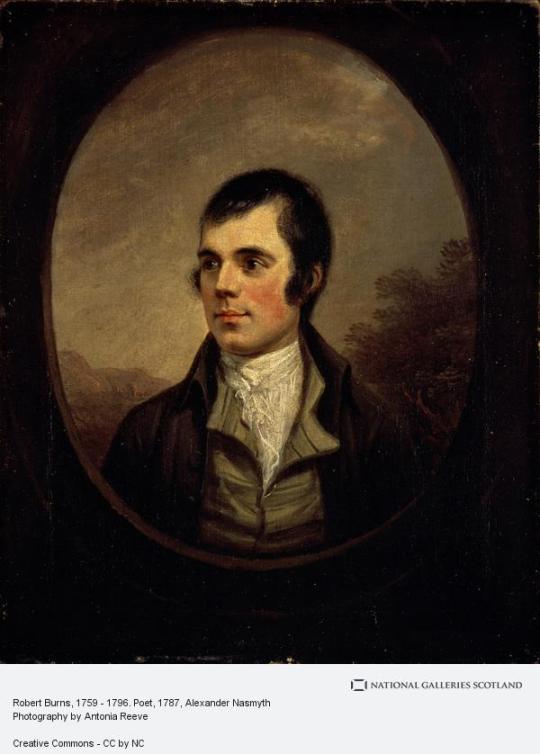

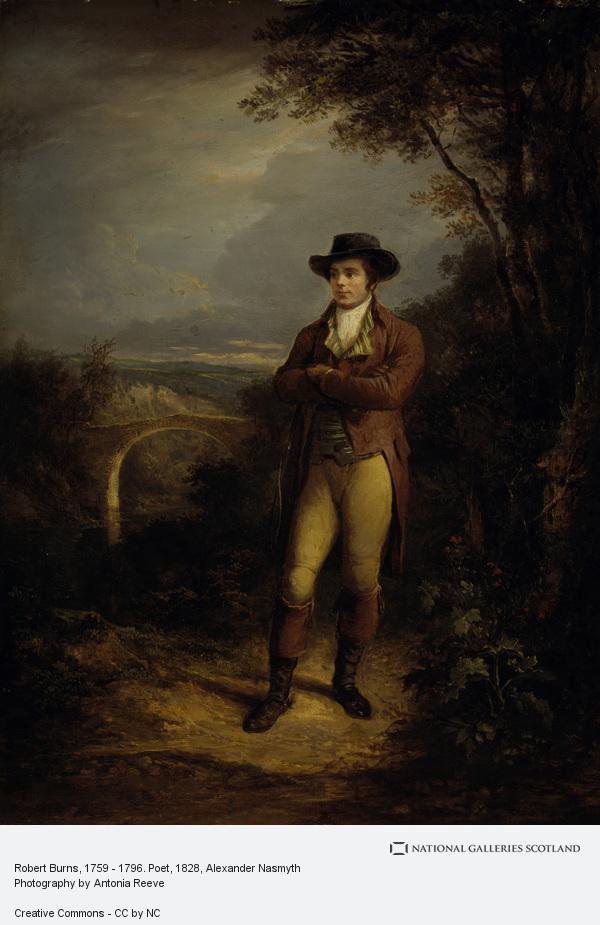

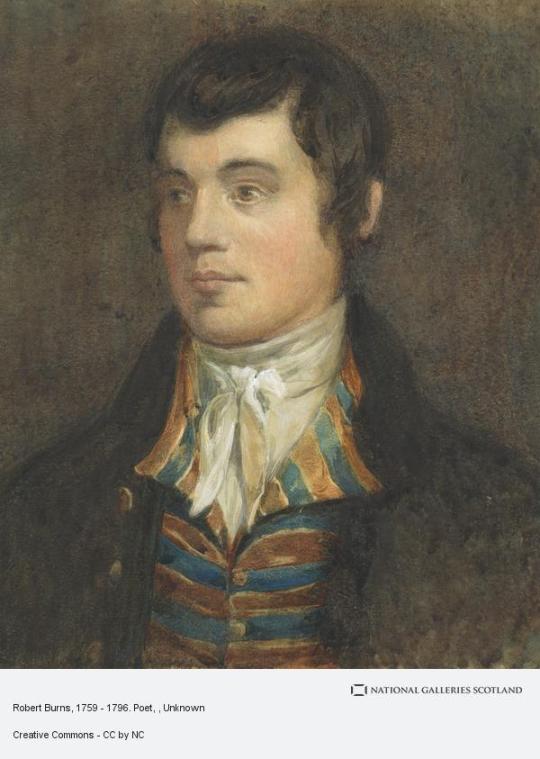
25th January marks the annual celebration of Burns Night - a time to celebrate Scotland's favourite son, and world renowned poet and song writer Robert Burns who was born on this day 1759.
I have covered Oor Rabbie on may occasions so on this day I hope to bring you a few facts about Scotland's National Bard and his legacy.
Known as somewhat of a ladies man, Burns is known to have fathered 12 or 13 children, depending on the source, to 4 different women. His last born child, Maxwell, was born on the same day as his funeral 25 July 1796, meaning his wife Jean Armour missed his send off.
As a lad growing up in Ayrshire, Burns was always fond of supernatural stories, most of which were told to him by an old widow who helped out on his father's farm. These stories no doubt had an influence on his writings in the future and perhaps were the inspiration for his classic masterpiece, Tam O'Shanter and the lesser known Adress to the Deil and Halloween. Even in these poems he flattered the fairer sex with his words, this from the latter poem.....
The lasses feat, an' cleanly neat, Mair braw than when they're fine; Their faces blythe, fu' sweetly kythe, Hearts leal, an' warm, an' kin':
Of course Burns also gives another of his favourite subjects a mention in this verse, "the deil himsel," Look it up it's another guid yin!
Burns didn't always want to stay in Scotland - he hoped to move to the Caribbean island of Jamaica. Although following the success of his poetry collection 'Poems, Chiefly in the Scottish Dialect' (or the Kilmarnock Edition as it is known), he opted to move closer to home, settling in Edinburgh for a time.
For all his fame, Burns never forgot his humble roots. His love for farming stayed with him throughout his life and his writing often dealt with issues affecting the poorer classes, notably highlighting the need for greater social equality. Indeed he is known as the Ploughman Poet, a nod to his farming life.
And on his legacy, Burns has gathered some very famous fans since his passing, US president Abraham Lincoln could recite Burns’ works by heart. Bob Dylan says that ‘A Red, Red Rose’ by Burns is his source of greatest creative inspiration and Michael Jackson song Thriller is said to have been inspired by Tam O'Shanter.
In Japan at pedestrian crossing you don't get beeps like here in Scotland, they play a rendition of the Burns song ‘Coming Through The Rye’.
There are more statues in honour of Rabbie than any other male figure in history, only surpassed in total by Queen Victoria. (I am not including religious statues).
In 2005 Robert Burns was the first person ever to feature on a bottle of Coca Cola, about a million were made they currently trade for around £10 and I have one, unopened in my kitchen cupboard.
Arguably Burns most famous song, Auld Lang Syne, has appeared in over 170 Hollywood films including The Apartment, It’s A Wonderful Life and When Harry Met Sally. , but he only rewrote the verse, he sent the poem to the Scots Musical Museum in 1788 indicating that it was an ancient song but that he'd been the first to record it on paper. The phrase 'auld lang syne' roughly translates as 'for old times' sake', and the song is all about preserving old friendships and looking back over the events of the year.
In the US city of Atlanta, there is a life-size imitation of Burns’ first home in Alloway, South Ayrshire, although it doesn't have the famous thatched roof.
In Scotland, there are some 20 official Burns memorials dotted around the country, from Aberdeen to the final resting place of Burns in Dumfries, which commemorate his journey from Ayrshire to “Auld Lang Syne”.
‘My Heart’s in the Highlands’ was translated and adopted as the marching song of the Chinese resistance fighter in the Second World War.
In 2009 STV viewers voted Robert Burns ‘The Great Scot’, beating the likes of William Wallace, Robert the Bruce among others.
There are Burns Clubs scattered across the globe, but the very first one, known as The Mother's Club, was founded in Greenock in 1801. They held the very first Burns Supper on what they thought was his birthday, January 29th 1802, only to discover that his birthday was actually January 25th!
Since then Burns suppers have been held worldwide.
I know some of you out there will toil to understand some of Burns's poetry, don't fear you will find the Best of Robert Burns, translated into the "de'il's tongue" just Click here...
The song Ae Fond Kiss, was one of my mums favourites the words "Never met-or never parted, We had ne'er been broken-hearted" are inscribed on her grave......"
43 notes
·
View notes
Text





Episode Descriptions:
Beyond the Sea: A death row inmate named Luther Lee Boggs claims that he is psychic and can lead Mulder to a serial killer in exchange for a lesser sentence of life in prison. The agents' roles are reversed in this episode, with Mulder doubting Boggs's claim and Scully believing him after she is told that she can communicate through him with her recently deceased father.
Fresh Bones: One morning, after two gruesome hallucinations, Private Jack McAlpin crashes his car into a tree that has a voodoo symbol drawn on it; the second death of a marine in two weeks that has featured that symbol. The marines in question were guarding a processing center for Haitian refugees, and when Mulder and Scully visit the center they find the deaths were not as unexpected as they seemed.
Musings of a Cigarette Smoking Man: Mulder, Scully and Byers meet with Frohike, where he details what may have been Cigarette Smoking Man's real life.
Field Trip: The skeletonized remains of a young couple are found in the fields of North Carolina. When Mulder and Scully go to investigate, they find that a giant fungal life form releases an LSD-like drug into the air with spores, and then slowly digests its victims. Mulder and Scully fall into its trap and are not sure of what is reality and what is fantasy.
Brand X: While protecting a man due to testify against the Morley cigarette company, Skinner is horrified when the witness dies mysteriously. What the agents soon discover is that a new brand of cigarette has a dangerous secret.
The information from this poll is collected from Katy DeCorah's mapbox of Jane Robert's "Mapping the X-Files"
Episode Descriptions are taken from wikipedia for neutrality.
#the x files#the x-files#txf#polls#north carolina#beyond the sea#fresh bones#musings of a cigarette smoking man#field trip#brand x#s1 e13#s2 e15#s4 e7#s6 e21#s7 e18#setting polls
4 notes
·
View notes
Text

Gayle Dean Wardlow: Chasin' That Devil's Music: Searching for the Blues (1998)
Contrary to what you may have heard -- or not heard, as it were -- Black History Month hasn't been canceled this year; in fact it's as vital and meaningful as it's ever been.
In my modest efforts to promote it, last week I wrote a few thoughts about Miles Davis' essential autobiography, which almost doubles as a history of jazz itself, so this week I'll turn to some music that's even closer to my heart: the blues.
Now, I own a lot of books about the blues and early 20th Century Delta Blues, in particular, but few of them build a more immersive facsimile of the harsh world that spawned these musicians than Gayle Dean Wardlow's Chasin' That Devil's Music: Searching for the Blues.
Why, by the time I finished reading it, I almost jumped in my car and drove off to find those mythical crossroads where the devil and these supernaturally gifted bluesmen supposedly conducted their nefarious business.
Born in Texas and reared in Mississippi, Wardlow began collecting blues 78s and their creators' untold stories in the 1960s, literally knocking on strangers' doors in search of first-hand accounts while cataloguing what few official records could be found.
His efforts dispelled a huge number of fallacies, falsehoods, and outright fantasy, and though Charley Patton and Robert Johnson drew the bulk of his obsession, Wardlow's investigations shed more light on an almost incomparable trove of lesser-known bluesmen.
Here's a short list to whet your whistle: Skip James, Tommy Johnson, Ishmon Bracey, Garfield Akers, Hayes McMullan, Peetie Wheatstraw (a.k.a. 'The Devil's Son-in-Law') -- all of whom make the comparatively well-known Elmore James a strange choice to grace the book's cover.
But this shouldn't deter you from digging into these reverential pages, ideally soundtracked by the accompanying CD, which combines vintage blues performances and some of Wardlow's personal recorded interviews with many of these legendary artists.
At a time when haters and trolls are complaining about Beyoncé winning a 'Best Country Album' Grammy -- as if white Americans haven't spent the past century shamelessly appropriating black music, art, and culture for their own benefit! -- books like this are more important than ever.
Featured Records:
Charley Patton: Complete Recorded Works Volume 2 (2013)
Tommy Johnson: Complete Recordings in Chronological Order (1928-30) (1998)
Peetie Wheatstraw: Volume One: The Devil’s Son-in-Law - 1930-1936 (1969)
Skip James: The Complete 1931 Session (1986)
Buy from: Amazon
#blues#country blues#devil#black history month#vinyl#charley patton#robert johnson#son house#howlin' wolf#blind lemon jefferson#tommy johnson#beyonce#peetie wheatstraw#Skip James#elmore james#hayes mcmullan#ishmon bracey#garfield akers#delta blues
2 notes
·
View notes
Text
Badger State Ghosts
Wisconsin's eminent folklorist Robert Gard once wrote, "Wisconsin has more ghosts per mile than any state in the nation." After surveying the spook scene, we have to conclude that he was absolutely correct. You can hardly swing a dead cat without hitting a ghost somewhere in the Badger State. In addition to Gard, the state owes a huge debt of gratitude to several other pioneers who gathered stories of nightwalkers, moon-flitters and other wispy death survivors. Charles E. Brown collected dozens of late-nineteenth-century and early twentieth-century stories, not only from the new European upstarts that took over the land, but from the people they displaced-the various Native American tribes.
In Haunted Wisconsin, by Beth Scott and Michael Norman, ghosts were taken out of dusty old archives and put into our living rooms where they belong. And Dennis Boyer has coaxed some amazing stories from saloon habitués, labor activists, and just plain Wisconsinites of all persuasions.
Paranormal researchers and organizations are keenly interested in investigating claims of hauntings and ghosts everywhere, from homes to businesses to abandoned buildings and cemeteries. Groups such as the Wisconsin Paranormal Research Center, the Wausau Paranormal Research Society, Wisconsin Ghost Investigations, and the Southern Wisconsin Paranormal Research Group and researchers such as Chad Lewis and Terry Fisk have all been active in scouring the state for haunted activity. These groups, if they've proven anything, have shown that Wisconsin is even more crowded with nonliving souls than Robert Gard could have imagined.
What follows is a selected survey, rather than an exhaustive assay of ghosts, featuring some lesser-known and surprising ones. To document all ghosts and haunted spots would require a book far longer than this. Talk to any group of people, and chances are, more than half of the group will have a story to share.
3 notes
·
View notes
Text

2024 reading summary:
Prey by Michael Chriton
Revelator by Daryl Gregory
Don't Believe It by Charlie Donlea
Wolfsong by TJ Klune
The Uninvited by Liz Jensen
We Spread by Ian Reid (⭐)
The Book Eaters by Sunyi Dean
The Andromeda Evolution by Daniel H. Wilson
Kiss My Asterisk: a Feisty Guide to Punctuation by Jenny Baranick
Starter Villain by John Scalzi
White Night by Jim Butcher
Small Favor by Jim Butcher
Turn Coat by Jim Butcher
Changes by Jim Butcher
Side Jobs by Jim Butcher
The Handmaid's Tale by Margaret Atwood
Looking Glass Sound by Catriona Ward (⭐)
Lexicon by Max Berry
Ghost Story by Jim Butcher
Cold Days by Jim Butcher
The Only Survivors by Megan Miranda
Cursed Bunny by Bora Chung
The Camp by Nancy Bush
Sister, Maiden, Monster by Lucy A. Snyder
The Stranger Upstairs by Lisa M. Martin
Things Have Gotten Worse Since we Last Spoke by Eric LaRocca
The Perfect Place to Die by Bryce Moore
Skin Game by Jim Butcher
Hemlock Island by Kelley Armstrong
The Devil in the White City: Murder, Magic and Madness at the Fair that changed America by Erik Larson
Redshirts by John Scalzi
The Lost Causes of Bleak Creek by Link Neal, Rhett McLaughlin
Brief Cases: More Stories From The Dresden Files by Jim Butcher
The Trees Grew Because I Bled There: Collected Stories by Eric LaRocca
Growing Things and Other Stories by Paul Tremblay
Creatures by John Langon, Paul Tremblay
Hidden Pictures by Jason Rekulak
Camp Damascus by Chuck Tingle
The Demonologist by Andrew Pyper
This is How You Lose The Time War by Max Goldstone, Amal El-Mohtar
Interior Darkness by Peter Straub
Bestiary by K-Ming Chang
Peace Talks by Jim Butcher
The Prisoner by B.A. Paris
The Only One Left by Riley Sager
Home is Where the Bodies Are by Jeneva Rose
Remarkably Bright Creatures by Shelby Van Pelt (⭐)
The Lesser Dead by Christopher Buehlman
Killers of a Certain Age by Deanna Raybourn
The Mountain in the Sea by Ray Nayler (⭐)
Battle Ground by Jim Butcher
Zombie by J. R. Angella
The Fold by Peter Clines
Chain-Gang All-Stars by Nana Kwame Adjei-Brenyah (⭐)
Everyone in my Family Has Killed Someone by Benjamin Stevenson
Everyone on This Train Is a Suspect by Benjamin Stevenson
You're Not Supposed to Die Tonight by Kalynn Bayron
Jack of Spades by Joyce Carol Oates
The King in Yellow by Robert W. Chambers
Carmilla by J. Sheridan Le Fanu
The Horla by Guy de Maupassant
Ella Minnow Pea: A Progressively Lipogrammatic Epistolary Fable by Mark Dunn (reread)
#noescape by Gretchen McNeil
Bury Your Gays by Chuck Tingle
Straight by Chuck Tingle
Dreadful by Caitlin Rozakis
Everyone This Christmas Has a Secret by Benjamin Stevenson
Horror Movie by Paul Tremblay (⭐)
#reading list#books#uhhhh ask me about any of these if you want#i like talking about books so. go for it
2 notes
·
View notes
Text


On one of his last assignments Julius Shulman together with his assistant Juergen Nogai in 2007 went to Chicago to document some of the city’s outstanding mid-century homes. Convinced and commissioned by sound engineer and architecture buff Gary Grand Shulman photographed gems by local heroes like Bertrand Goldberg, Keck & Keck and Harry Weese but also lesser-known architects like Edward Humrich and Robert Hausner.
Two years after Shulman’s death Gand as a tribute to the late master photographer published „Julius Shulman: Chicago Midcentury Modernism“ with Rizzoli, a lavish document of both Shulman’s brilliance and the rich mid-century architecture of Chicago. The volume collects a total of eleven houses, each of them presented in comprehensive dossiers containing Shulman’s photographs and an essay recounting the respective house’s history. Especially the commentaries by original inhabitants and architects provide most interesting information about the commission, the requirements it had to accommodate as well as the design process.
Julius Shulman in turn once more proves his genius for perspective and composition: despite the at times severely altered interiors he nonetheless manages to reveal the quality of the building’s design and how it is embedded in the surrounding landscape.
„Julius Shulman: Chicago Midcentury Modernism“ is the product of two modern architecture enthusiasts that not only proves Pierre Koenig’s remark that „There’s no midcentury modernism in Chicago“ wrong but also demonstrates the quality of the city’s mid-century modern domestic architecture. A real treasure trove!
#julius shulman#architectural photography#architecture book#architecture#usa#chicago#mid century modern#book
22 notes
·
View notes
Text

[The hagiography is from Lesser Feasts and Fasts 2022, p. 360: Jonathan Myrick Daniels :: Martyr, 1965]
Today on the Church Calendar is the Feast of Jonathan Myrick Daniels, Saint and Martyr. The Collect of the Day is from Lesser Feasts and Fasts 2022, p. 361:
O God of justice and compassion, who puts down the proud and mighty from their place, and lifts up the poor and the afflicted: We give you thanks for your faithful witness Jonathan Myrick Daniels, who, in the midst of injustice and violence, risked and gave his life for another; and we pray that we, following his example, may make no peace with oppression; through Jesus Christ our Savior, who lives and reigns with you and the Holy Spirit, one God, for ever and ever. Amen.
+
Jonathan Myrick Daniels was born in Keene, New Hampshire, in 1939. Like many young adults, from high school in Keene to graduate school at Harvard, Jonathan wrestled with vocation. Attracted to medicine, ordained ministry, law, and writing, he found himself close to a loss of faith until his discernment was clarified by a profound conversion on Easter Day 1962 at the Church of the Advent in Boston. Jonathan then entered the Episcopal Theological School in Cambridge, Massachusetts.
In March 1965, the televised appeal of Martin Luther King, Jr., to come to Selma to secure for all citizens the right to vote touched Jonathan’s passions for the well-being of others, the Christian witness of the church, and political justice. His conviction was deepened at Evening Prayer during the singing of the Magnificat: “He hath put down the mighty from their seat and hath exalted the humble and meek. He hath filled the hungry with good things.” He wrote: “I knew that I must go to Selma. The Virgin’s song was to grow more and more dear to me in the weeks ahead.”
In Selma he found himself in the midst of a time and place where the nation’s racism and the Episcopal Church’s share in that inheritance were exposed. Greatly moved by what he saw and experienced, he returned to seminary, asked leave to work in Selma while continuing his studies, and returned there under the sponsorship of the Episcopal Society for Cultural and Racial Unity.
After a brief return to Cambridge in May to complete his exams, he returned to Alabama to resume his efforts assisting those engaged in the integration struggle. Jailed on August 14 for joining a picket line, Jonathan and his companions resolved to remain together until bail could be posted for all of them, as it was six days later. Released and aware that they were in danger, four of them walked to a small store. As sixteen-year-old Ruby Sales reached the top step of the entrance, a man with a shotgun appeared, cursing her. Jonathan pulled her to one side to shield her from the unexpected threats and was killed instantly by the 12-gauge blast.
Jonathan’s letters and papers bear eloquent witness to the profound effect that Selma had upon him. He writes, “The doctrine of the creeds, the enacted faith of the sacraments, were the essential preconditions of the experience itself. The faith with which I went to Selma has not changed: it has grown . . . I began to know in my bones and sinews that I had been truly baptized into the Lord’s death and resurrection . . . with them, the black men and white men, with all life, in him whose Name is above all the names that the races and nations shout . . . We are indelibly and unspeakably one.”
[Robert Scott Horton]
9 notes
·
View notes
Photo
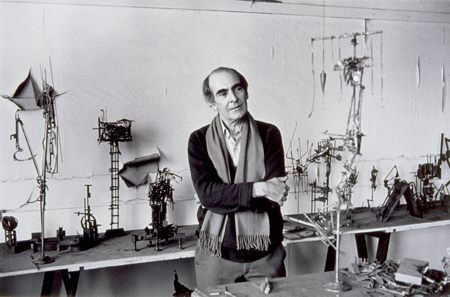

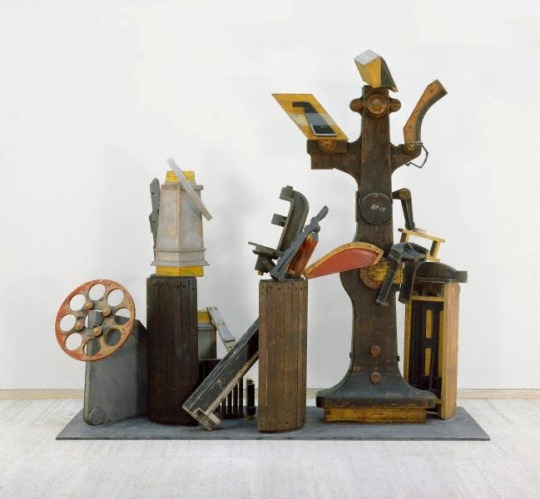

Klippel with assemblages in his studio
Number 1060, (1995) painted wire, tin 22.5 x 7.6 x 7cm
Number 714 - Prototype for Adelaide Plaza (1988) Construction of brazed and welded steel, geometric sections, found objects, formed sheet metal. 69.5 x 64 x 49.5 cm without base
Number 329, (1977) assemblage of collected wood parts 300 x 350 x 135cm
search @www.artgallery.nsw.gov.au
A Klippel's practice exeplifies the interconnectedness of the conceptual and the material. His bodies of work explore the relationship between the organic and the mechanical.
B By the time Robert Klippel died in Sydney in 2001, aged 81, he was critically acclaimed and well collected in his home country. But as with most Australian artists, although he had lived for stints in Europe and the US from the 1940s until the 1960s, his work was largely unknown abroad.
Eleven years on, his son has secured a blue chip shot at changing that. Klippel junior has signed Galerie Gmurzynska in Zurich as the sole representative of his father’s estate worldwide, catapulting the artist into the company of Pablo Picasso, Yves Klein, Alexander Rodchenko and David Smith, whose estates the gallery also represents.
Some of Klippel’s large wooden sculptures have already been on the Gmurzynska stand at Art Basel, Art Basel Miami and ArtHK, and a substantial publication and exhibition is being planned for the coming year.
Klippel is the only Australian artist to have been taken on by the 50-year-old gallery, which is best known for introducing the Russian avant garde to western Europe and for representing modernist artists working up to 1980.
“We have a solid reputation for scientific research, and for promoting interesting, important historic figures who have created something authentic but who have not had the exposure they should have had,” says gallery co-owner Mathias Rastorfer.
Klippel, an abstract artist and loner not easily slotted into one particular movement, was loosely influenced by surrealism, cubism and constructivism.
According to Deborah Edwards in the 2002 Art Gallery of NSW retrospective catalogue, “his attitudes to art making were grounded in European modernism and postwar intellectual thought”. It is for this reason, in part, that Gmurzynska was interested in taking him on.
Rastorfer says: “We found him very interesting due to his connection to the constructivists, his Polish origins, his time in America. The more you go into Klippel, the more modernist links you find.
“We will introduce his work in the context of those peers, taking him out of the Australian context and putting him into an international one. We want to show where he fits in worldwide.”
Klippel’s bronze sculptures have been the most collectable in Australia. They appear regularly on the secondary market and can fetch more than $100,000. The top price paid at auction – $507,800 – was in 2006 for a miniature steel, tin, acrylic paint and coloured paper collage.
Gmurzynska plans to use the large, wooden sculptures and tiny coloured plastic ones that Klippel did in the late 1980s and early 1990s to introduce him internationally. This is in part for practical reasons, because this is most of what is left in the estate, but also because he thinks these will work best there.
Rastorfer expects to take at least three years to achieve traction internationally for Klippel. “One of the biggest temptations is to sell the four or five most important works straight away, because that’s the easiest thing to do,” he says. “But then the estate is left with the lesser known work and often doesn’t know what to do with it.
“It’s about placement in museum collections, in significant private collections, and with opinion makers, not just about selling. If we show him in the context of his better- known peers, the rest will follow.”
There are no guarantees the strategy will work, but Andrew Klippel is quietly excited that his father, to whom he was very close, is getting a posthumous chance at an international career.
After years in the music business, where things happen very quickly, his foray into the visual arts is teaching him a new virtue: patience. “This is a long play.”
Katrina Strickland http://www.afr.com (2012)
2 notes
·
View notes
Text

Titan Maximum #2: "Busted" | October 4, 2009 - 11:30PM | S01E02
The second dang episode of Titan Maximum is basically a second pilot, taking us through how the newly formed team navigates the bureaucracy of the future government in order to get a replacement giant robot to pilot and have space adventures with. There’s also a little bit of advancement with the villain of the show, a former member of the team. I don’t think I touched on that aspect even a little bit last time. The important thing to know is, they get themselves reinstated with the military and the little brother nerd kid is their new engineer, producing a new mech that’s seemingly superior in every way, except the face is hastily drawn on. The episode ends with them about to do their first actual episodic adventure.
The main characters on the show are mostly dicks. We see them do stuff that dicks do to be dicks and for no other reason other than because they are dicks. That’s the comedy, dicks being dicks. Okay. That’s fine, I guess, if you're not me. In this one we have a flashback to them raping the “statue of unity”, because they were drunk and acting arrogantly for, again, no real reason. Then at one point they do a joke where a grunt foot soldier in another part of the story says an obvious sexual joke out loud and there’s pronounced awkward silence. It’s just like, man, what point are you even making here?
There wasn’t a single funny joke in this whole episode. I started getting actually pissed off. So much so that I failed to keep good notes for this episode; I literally wrote “JESUS FUCKING CHRIST THIS SUCKS” in a few different iterations without saying what I was reacting to. I should’ve been writing stuff like “the mean slut is showing her tits and being nasty.” Why, it’s like a season three episode of Sealab 2021, except for it probably took a year to animate instead of an afternoon.
I watched this on adultswim.com, and I’m probably going to get a DVD or download of this or something to watch instead. I was literally getting like, cartoonishly angry at this show, so much so that I started punching stuff. I am a lunatic, yes, but usually bad shows don’t upset me this much. Then, midway through the episode? I swear to fucking god, there was like 4 minutes of ads. They just jammed a commercial break in and it took for fucking ever. Every time a new ad started I actually started growling. Lotta ads for new shows coming soon to HBOMax. They all look like shit. Goddamn, I have never hated an app more than that app. I am thankful I don’t actually pay for it myself.
To make it even worse: the one thing I stated as a positive about this show was the closing credits, which they interrupt for a lame callback joke. Then after the credits are over, they include a tag where a housekeeper explains an earlier joke where somebody pees in their space suit thinking it has a waste collection receptacle even though it doesn’t. Yeah, I saw that episode of Venture Bros. too.
MAIL BAG
got me katanas i want you to know, slicing up doors i want you to know, girl it's home movies i want you to know, don't know about you but i am wack...y coach mcguirk, wanna grow up to be, be a bob belcher
this was nice, pal, and I got a good laugh outta the deal. Well, see ya!
What can Delocated do in Season 2 to win you back? You seemed really down on it by the end. You didn't even like the part where he named all of Paul Rudd's lesser known movies.
You are full of shit! I literally named the final episode my favorite episode so far. I think all the feelings I had for the show roughly resembled the feelings I had for it back when it premiered. You're ignorant, pal.
He was in Anchorman, and The 40 Year Old Virgin, he was in The Shape of Things. He was in Clueless and Romeo + Juliet. He did a thing in Reno 911: Miami. The Cider House Rules. P.S. The Oh In Ohio. Knocked Up. He had a series of Broadway credits: The Last Night of Ballyhoo. Three Days of Rain with Julia Roberts. Twelfth Night at Lincoln Center. HE WAS IN HOUSE HUNTING!
"I like this" -me. See, now leave me alone.
Honestly I really like the *premise* of Titan Maximum. it's surprisingly earnest with it's deconstruction of Voltron, the character drama, the running story had a lot of potential, it looks great, Even the implied worldbuilding is fun. But like you said, the character writing is AWFUL. It's like a time capsule of the late 2000s "Workaholics" writers' board (twitter DOT com/podimportant/status/1369836756971835402). It sucks cause I like everything else about it but it really brings it down.
I probably should've noted this in the first episode, but I've never been a Voltron devotee. I don't remember ever watching it as a kid, and I've only seen a couple episodes as an Adult out of curiosity. So some of this show is probably lost on me. But the writing is so bad, I would highly doubt it would add anything for me.
4 notes
·
View notes
Text

During 1691, Jack Teague was born during a typhoon aboard a pirate ship. Named after the brother of his father, Edward Teague, Jack grew up without his unknown mother amid the seafaring outlaws at Shipwreck Cove on Shipwreck Island. Not eager to be yet another crewmate, Jack Teague insisted on one day becoming a captain of his own vessel. After serving as a cabin boy, he would find himself the captain of the Barnacle, a small fishing boat that had been left abandoned at Salty Cove on the island of Tortuga.
After a bout of adventures around the Gulf of Mexico, the Grand Barnacle would be destroyed in a confrontation with the English Royal Navy by cannonfire intended for Edward Teague’s ship, the Misty Lady.
After many more adventures, Jack would later find himself as a crewmember of the Wicked Wench, under the captaincy of Captain Morgan (not to be confused with the buccaneer and later governor of Port Royal of the same name), when they would be confronted by Capitan Armando Salazar around 1711. Salazar had been in command of the Spanish galleon, Silent Mary, and had been putting effort into the extermination of pirates in the West Indies out of vengeance for his father and grandfather who had perished at the hands of pirates. The battle would take place near the Devil’s Triangle west of the Windard Isles in the Lesser Antilles, and would see the Silent Mary destroyed as she ran aground a collection of rocks shortly after entering the triangle while in pursuit of the Wicked Wench - a result of actions spurred on by Jack “the Sparrow.” For a while, Jack found himself elected captain of the vessel, as their captain had perished in the confrontation.
Some time later, Jack no longer found himself aboard the Wicked Wench, as he had been press-ganged into service aboard a French brigantine named La Vipere, captained by Christophe-Julien de Rapier. Not long after, he had been left at sea in a longboat with fellow crewmate Robert Greene. Upon reaching dry land again, the duo began working for the East India Trade Company for five years, and Jack served as first mate aboard the brig Fair Wind. In 1716, after taking control of the Fair Wind, defending her from pirates, Jack Sparrow was offered captaincy of the merchant vessel Wicked Wench (which had apparently fallen into EITC hands by this point) by an impressed Lord Cutler Beckett, who was a director of the company regarding West Africa.
After a number of voyages on behalf of the East India Trading Company, Jack had been ordered to deliver a cargo of enslaved Africans to New Avalon in the Bahamas. Jack however despised the idea of humans being deemed as cargo and instead freed them, stealing Beckett’s ship. Shortly afterwards, a number of vessels were dispatched to capture the pirate Jack Sparrow, and before long he found himself imprisoned.
Months later, Jack would be brought to the coast of West Africa and be branded upon his arm with a “P” labeling him forever as a pirate. Just off the shore, he was made to watch as the Wicked Wench was torched. Breaking free from his captors, he swam for the ship but found himself trapped within her cabins as she sank beneath the waves.
Jack Sparrow found himself somewhere between life and death, on the path to Davy Jone’s Locker or the Land of the Dead. There, a deal was struck with Davy Jones that if Jones would raise his ship, after thirteen years he would forfeit his captaincy and serve onboard Jones’ ship, the Flying Dutchman. The blackened, charred ship would rise above the waves once more and be renamed the Black Pearl.
Two years later, in 1718, Jack would have Hector Barbossa aboard the Black Pearl, naming him first mate in a voyage to search for Aztec gold that had been stashed by Cortes. Prior to its discovery, the crew mutinied, an act which Barbossa spurred into being. Jack was marooned on a desert island, and Barbossa claimed captaincy of the Black Pearl.
Jack Sparrow would escape his solitude on the desert isle, and sail the seas having many more adventures over the next 11 years, until Jones would later reappear to him in 1729.
6 notes
·
View notes
Photo

A new variant has been added!
Lesser Jacana (Microparra capensis) © Robert Taylor
It hatches from blue, distinctive, hooting, immature, pale, quick, small, top, uncommon, and white eggs.
squawkoverflow - the ultimate bird collecting game 🥚 hatch ❤️ collect 🤝 connect
1 note
·
View note
Text
The Declaration of Independence and Thomas Jefferson’s Contribution: A Fascinating History
In July 1776, the historic decision by the U.S. Congress to adopt the Declaration of Independence marked a pivotal chapter in American history. Today, Independence Day is still celebrated as a national holiday on July 4. However, there are several intriguing details about this event that many may not know. While Thomas Jefferson’s contribution to American history is undeniable, several other significant events were also part of this declaration’s story. In this article, we will highlight these lesser-known facts and Jefferson’s stance on slavery.
youtube
The History of the Declaration of Independence: In 1776, the American Continental Congress adopted the Declaration of Independence, declaring freedom from British rule. This declaration laid the foundation for American independence and is considered one of the most crucial days in U.S. history, celebrated as the nation’s “birthday.” However, there are many interesting and lesser-known aspects of this historical event. Extensive research on the declaration and Jefferson’s role has revealed many surprising facts.
Thomas Jefferson and Drafting the Declaration: Thomas Jefferson, who later became the third President of the United States, was entrusted with drafting the declaration. Though he is often credited as the main author, Jefferson was actually part of a committee of five. Alongside him were John Adams, Benjamin Franklin, Roger Sherman, and Robert Livingston. Together, they crafted this historic document through their collective efforts.
Influence of Other Writers on Jefferson’s Language and Phrases: The language and phrases of Jefferson’s Declaration of Independence are still considered some of the finest in American history. However, many do not know that some of his most memorable words were borrowed from other writers. Jefferson gathered inspiration from various philosophers and ancient texts and rephrased them creatively. This blend of ideas stands as a testament to his ingenuity, which immortalized him in history.
The Topic of Slavery in the Declaration: Jefferson originally included a passage in the draft condemning the inhumanity of slavery, describing it as harmful and degrading to humanity. However, this section was later removed from the final draft. Congress did not want any mention of slavery in the founding document, as it remained a contentious issue. The absence of this passage about slavery had a lasting impact on American history, complicating the foundation of the nation and its values.
The Concept of Freedom in the Declaration: The Declaration of Independence is not just a symbol of America’s freedom but also a crucial step toward human rights. It famously states that “all men are created equal” and that it is the government’s responsibility to ensure liberty and equality for all. However, by omitting any mention of slavery, Congress left a contradiction within the nation’s founding. This decision influenced the future of American society, spurring both debate and activism around slavery, which continued into the Civil War.
Conclusion: The Declaration of Independence and Thomas Jefferson’s contribution have left an indelible mark on American history. This historic moment and the discussions around slavery make it evident that the journey for liberty and equality has always been a challenging one. The significance of Jefferson and this declaration remains timeless in U.S. history, reminding us that the struggle for freedom is an ongoing endeavor.
Watch More: McDonald's Speedy System: How This Ketchup Gun Revolutionized the Fast Food Industry
youtube
Tags: যুক্তরাষ্ট্রেরস্বাধীনতারঘোষণা, থমাসজেফারসন, মার্কিনইতিহাস, স্বাধীনতাআন্দোলন, দাসপ্রথা, যুক্তরাষ্ট্রেরজন্মদিন, মার্কিনসংবিধান, স্বাধীনতারদিবস, যুক্তরাষ্ট্রেরইতিহাস, স্বাধীনতাএবংসমতা, যুক্তরাষ্ট্রেরস্বাধীনতা, ইতিহাসেরচমকপ্রদতথ্য DeclarationofIndependence, ThomasJefferson, AmericanHistory, Independencemovement, Slavery, USBirthday, AmericanConstitution, IndependenceDay, USHistory, LibertyandEquality, USIndependence, HistoricalFacts
#যুক্তরাষ্ট্রেরস্বাধীনতারঘোষণা #থমাসজেফারসন #মার্কিনইতিহাস #স্বাধীনতাআন্দোলন #দাসপ্রথা #যুক্তরাষ্ট্রেরজন্মদিন #মার্কিনসংবিধান #স্বাধীনতারদিবস #যুক্তরাষ্ট্রেরইতিহাস #স্বাধীনতাএবংসমতা #যুক্তরাষ্ট্রেরস্বাধীনতা #ইতিহাসেরচমকপ্রদতথ্য #DeclarationofIndependence #ThomasJefferson #AmericanHistory #Independencemovement #Slavery #USBirthday #AmericanConstitution #IndependenceDay #USHistory #LibertyandEquality #USIndependence #HistoricalFacts #fyp #reels #viral #highlights
#যুক্তরাষ্ট্রেরস্বাধীনতারঘোষণা#থমাসজেফারসন#মার্কিনইতিহাস#স্বাধীনতাআন্দোলন#দাসপ্রথা#যুক্তরাষ্ট্রেরজন্মদিন#মার্কিনসংবিধান#স্বাধীনতারদিবস#যুক্তরাষ্ট্রেরইতিহাস#স্বাধীনতাএবংসমতা#যুক্তরাষ্ট্রেরস্বাধীনতা#ইতিহাসেরচমকপ্রদতথ্য DeclarationofIndependence#ThomasJefferson#AmericanHistory#Independencemovement#Slavery#USBirthday#AmericanConstitution#IndependenceDay#USHistory#LibertyandEquality#USIndependence#HistoricalFacts#Youtube
0 notes